lights Seat Altea Freetrack 2010 Owner's Guide
[x] Cancel search | Manufacturer: SEAT, Model Year: 2010, Model line: Altea Freetrack, Model: Seat Altea Freetrack 2010Pages: 294, PDF Size: 7.71 MB
Page 116 of 294
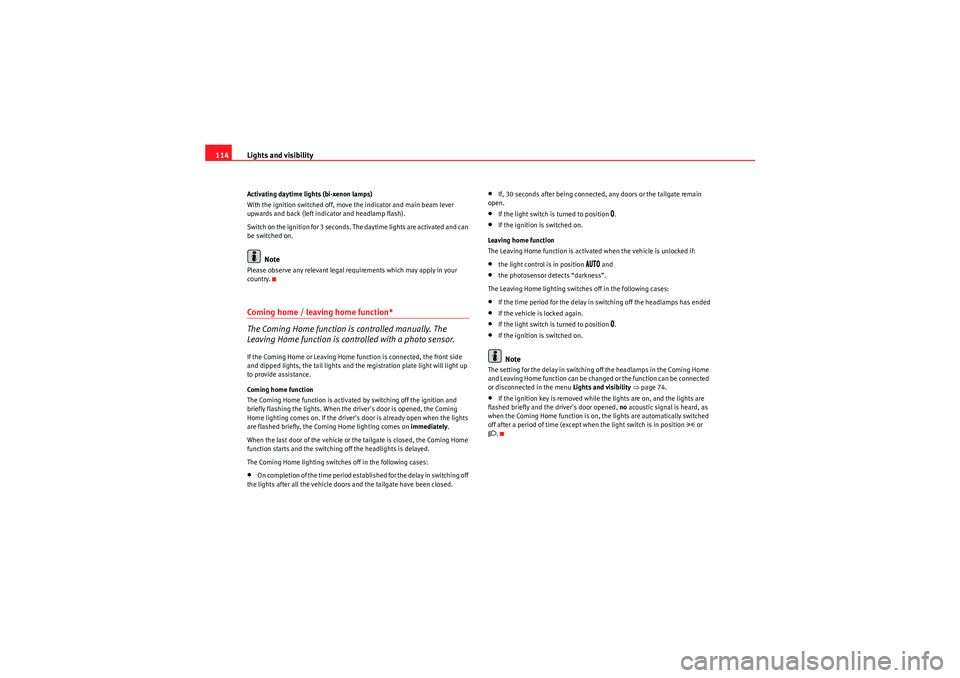
Lights and visibility
114Activating daytime lights (bi-xenon lamps)
With the ignition switched off, move the indicator and main beam lever
upwards and back (left indicator and headlamp flash).
Switch on the ignition for 3 seconds. The daytime lights are activated and can
be switched on.
Note
Please observe any relevant legal requirements which may apply in your
country.Coming home / leaving home function*
The Coming Home function is controlled manually. The
Leaving Home function is controlled with a photo sensor.If the Coming Home or Leaving Home function is connected, the front side
and dipped lights, the tail lights and the registration plate light will light up
to provide assistance.
Coming home function
The Coming Home function is activated by switching off the ignition and
briefly flashing the lights. When the driver's door is opened, the Coming
Home lighting comes on. If the driver's door is already open when the lights
are flashed briefly, the Coming Home lighting comes on immediately.
When the last door of the vehicle or the tailgate is closed, the Coming Home
function starts and the switching off the headlights is delayed.
The Coming Home lighting switches off in the following cases:•On completion of the time period established for the delay in switching off
the lights after all the vehicle doors and the tailgate have been closed.
•If, 30 seconds after being connected, any doors or the tailgate remain
open.•If the light switch is turned to position
.
•If the ignition is switched on.
Leaving home function
The Leaving Home function is activated when the vehicle is unlocked if:•the light control is in position
and
•the photosensor detects “darkness”.
The Leaving Home lighting switches off in the following cases:•If the time period for the delay in switching off the headlamps has ended•If the vehicle is locked again.•If the light switch is turned to position
.
•If the ignition is switched on.Note
The setting for the delay in switching off the headlamps in the Coming Home
and Leaving Home function can be changed or the function can be connected
or disconnected in the menu Lights and visibility ⇒ page 74.•If the ignition key is removed while the lights are on, and the lights are
flashed briefly and the driver's door opened, no acoustic signal is heard, as
when the Coming Home function is on, the lights are automatically switched
off after a period of time (except when the light switch is in position
or
.
Freetrack_EN.book Seite 114 Donnerstag, 10. September 2009 10:33 10
Page 117 of 294
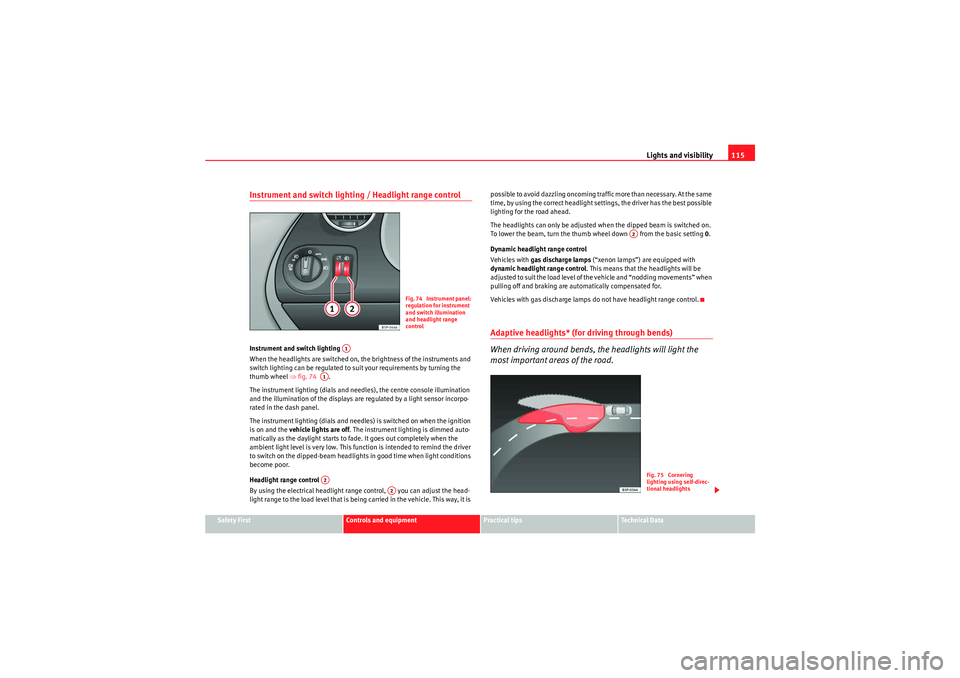
Lights and visibility115
Safety First
Controls and equipment
Practical tips
Technical Data
Instrument and switch lighting / Headlight range controlInstrument and switch lighting
When the headlights are switched on, the brightness of the instruments and
switch lighting can be regulated to suit your requirements by turning the
thumb wheel ⇒fig. 74 .
The instrument lighting (dials and needles), the centre console illumination
and the illumination of the displays are regulated by a light sensor incorpo-
rated in the dash panel.
The instrument lighting (dials and needles) is switched on when the ignition
is on and the vehicle lights are off . The instrument lighting is dimmed auto-
matically as the daylight starts to fade. It goes out completely when the
ambient light level is very low. This function is intended to remind the driver
to switch on the dipped-beam headlights in good time when light conditions
become poor.
Headlight range control
By using the electrical headlight range control, you can adjust the head-
light range to the load level that is being carried in the vehicle. This way, it is possible to avoid dazzling oncoming traffic more than necessary. At the same
time, by using the correct headlight settings, the driver has the best possible
lighting for the road ahead.
The headlights can only be adjusted when the dipped beam is switched on.
To lower the beam, turn the thumb wheel down from the basic setting
0.
Dynamic headlight range control
Vehicles with gas discharge lamps (“xenon lamps”) are equipped with
dynamic headlight range control . This means that the headlights will be
adjusted to suit the load level of the vehicle and “nodding movements” when
pulling off and braking are automatically compensated for.
Vehicles with gas discharge lamps do not have headlight range control.
Adaptive headlights* (for driving through bends)
When driving around bends, the headlights will light the
most important areas of the road.
Fig. 74 Instrument panel:
regulation for instrument
and switch illumination
and headlight range
control
A1
A1A2
A2
A2
Fig. 75 Cornering
lighting using self-direc-
tional headlights
Freetrack_EN.book Seite 115 Donnerstag, 10. September 2009 10:33 10
Page 118 of 294
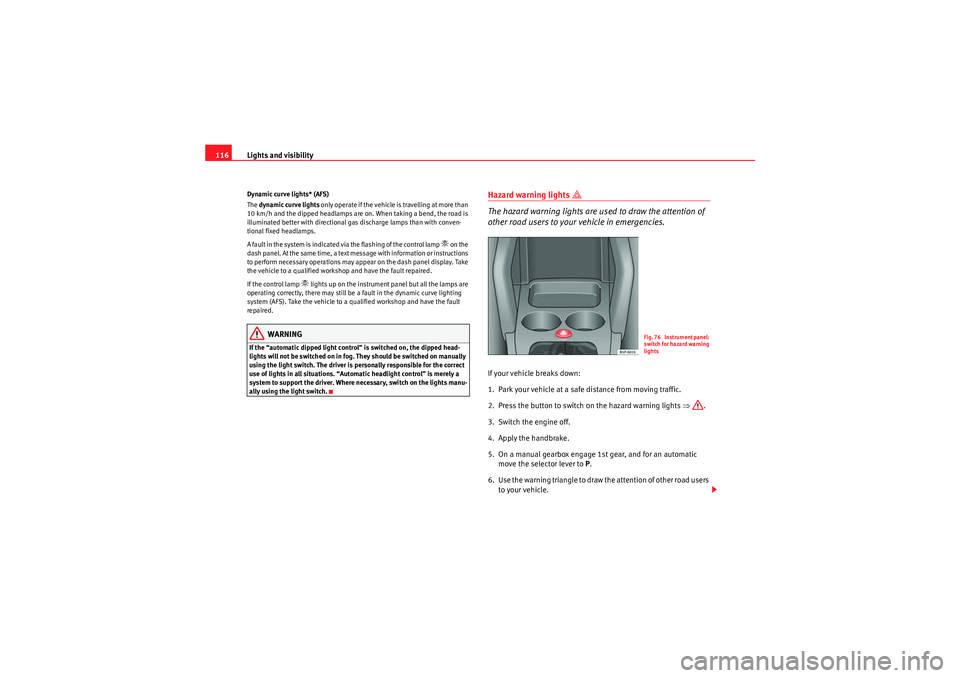
Lights and visibility
116Dynamic curve lights* (AFS)
The dynamic curve lights only operate if the vehicle is travelling at more than
10 km/h and the dipped headlamps are on. When taking a bend, the road is
illuminated better with directional gas discharge lamps than with conven-
tional fixed headlamps.
A fault in the system is indicated via the flashing of the control lamp
on the
dash panel. At the same time, a text message with information or instructions
to perform necessary operations may appear on the dash panel display. Take
the vehicle to a qualified workshop and have the fault repaired.
If the control lamp
lights up on the instrument panel but all the lamps are
operating correctly, there may still be a fault in the dynamic curve lighting
system (AFS). Take the vehicle to a qualified workshop and have the fault
repaired.
WARNING
If the “automatic dipped light control” is switched on, the dipped head-
lights will not be switched on in fog. They should be switched on manually
using the light switch. The driver is personally responsible for the correct
use of lights in all situations. “Automatic headlight control” is merely a
system to support the driver. Where necessary, switch on the lights manu-
ally using the light switch.
Hazard warning lights
The hazard warning lights are used to draw the attention of
other road users to your vehicle in emergencies.
If your vehicle breaks down:
1. Park your vehicle at a safe distance from moving traffic.
2. Press the button to switch on the hazard warning lights ⇒.
3. Switch the engine off.
4. Apply the handbrake.
5. On a manual gearbox engage 1st gear, and for an automatic move the selector lever to P.
6. Use the warning triangle to draw the attention of other road users to your vehicle.
Fig. 76 Instrument panel:
switch for hazard warning
lights
Freetrack_EN.book Seite 116 Donnerstag, 10. September 2009 10:33 10
Page 119 of 294
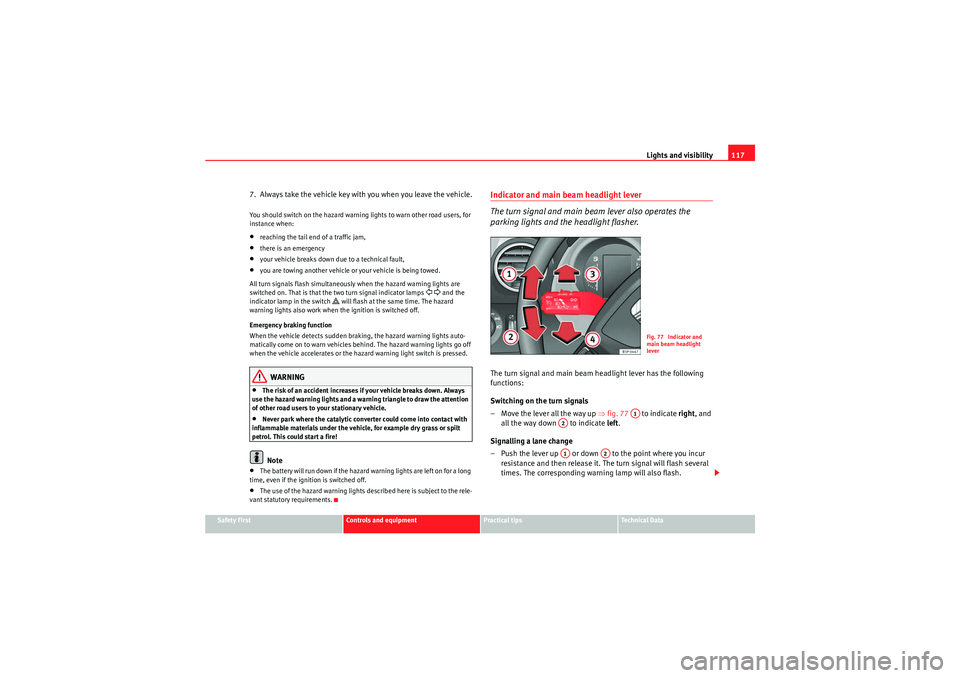
Lights and visibility117
Safety First
Controls and equipment
Practical tips
Technical Data
7. Always take the vehicle key with you when you leave the vehicle.You should switch on the hazard warning lights to warn other road users, for
instance when:•reaching the tail end of a traffic jam,•there is an emergency•your vehicle breaks down due to a technical fault,•you are towing another vehicle or your vehicle is being towed.
All turn signals flash simultaneously when the hazard warning lights are
switched on. That is that the two turn signal indicator lamps
and the
indicator lamp in the switch
will flash at the same time. The hazard
warning lights also work when the ignition is switched off.
Emergency braking function
When the vehicle detects sudden braking, the hazard warning lights auto-
matically come on to warn vehicles behind. The hazard warning lights go off
when the vehicle accelerates or the hazard warning light switch is pressed.
WARNING
•The risk of an accident increases if your vehicle breaks down. Always
use the hazard warning lights and a warning triangle to draw the attention
of other road users to your stationary vehicle.•Never park where the catalytic converter could come into contact with
inflammable materials under the vehicle, for example dry grass or spilt
petrol. This could start a fire!Note
•The battery will run down if the hazard warning lights are left on for a long
time, even if the ignition is switched off.•The use of the hazard warning lights described here is subject to the rele-
vant statutory requirements.
Indicator and main beam headlight lever
The turn signal and main beam lever also operates the
parking lights and the headlight flasher.The turn signal and main beam headlight lever has the following
functions:
Switching on the turn signals
– Move the lever all the way up ⇒fig. 77 to indicate right , and
all the way down to indicate left.
Signalling a lane change
– Push the lever up or down to the point where you incur resistance and then release it. The turn signal will flash several
times. The corresponding warning lamp will also flash.
Fig. 77 Indicator and
main beam headlight
lever
A1
A2A1
A2
Freetrack_EN.book Seite 117 Donnerstag, 10. September 2009 10:33 10
Page 120 of 294

Lights and visibility
118
Switching main beam on and off
– Turn the light switch to position
.
–Press the lever forward ⇒page 117, fig. 77 to switch on the
main beams.
– Pull the lever back towards you to switch the main beam head- lights off again.
Headlight flashers
– Pull the lever towards the steering wheel to operate the flasher.
Switching on parking lights
– Switch the ignition off and remove the key from the lock.
– Move the lever up or down to turn the right or left-hand parking lights on, respectively.
WARNING
The main beam can dazzle other drivers. Risk of accident! Never use the
main beam headlights or the headlight flasher if they could dazzle other
drivers.
Note
• The turn signals only work when the ignition is switched on. The corre-
sponding warning lamp
or flashes on the dash panel. The warning lamp
flashes when the turn signals are operated, provided a trailer is correctly
attached and connected to the vehicle. If a turn signal bulb is defective, the
warning lamp flashes at double speed. If the trailer turn signal bulbs are
damaged, warning lamp
does not light up. Change the bulb.
•The main beam headlights can only be switched on if the dipped beam
headlights are already on. The warning lamp
then lights up on the dash
panel.
•The headlight flasher comes on for as long as you pull the lever – even if
no other lights are switched on. The warning lamp
then lights up on the
dash panel.
•When the parking lights are switched on, the headlight and the rear light
on the corresponding side of the vehicle light up. The parking lights will only
work if the key is removed from the ignition. If the lights are switched on, a
buzzer gives an audible warning while the driver door is open.•If the turn signal lever is left on after the key has been taken out of the
ignition lock, an acoustic signal sounds when the driver door is opened. This
is a reminder to switch off the turn signal, unless of course you wish to leave
the parking light on.
A3
A4
Freetrack_EN.book Seite 118 Donnerstag, 10. September 2009 10:33 10
Page 121 of 294

Lights and visibility119
Safety First
Controls and equipment
Practical tips
Technical Data
Interior lightsFront interior light type 1The switch ⇒fig. 78 is used to select the following positions:
Courtesy light position
Rocker switch in flat position (not activated). The interior lights are automat-
ically switched on when the vehicle is unlocked or the key removed from the
ignition lock And turn off approx. 20 seconds after closing the doors. The inte-
rior lights are switched off when the vehicle is locked or when the ignition is
switched on.
Interior light switched on
Push the switch to the position
.
Interior light switched off O
Push the switch to position O ⇒fig. 78.
Note
If not all the vehicle doors are closed, the interior lights will be switched off
after approx. 10 minutes, providing the key has been removed and the cour-
tesy light position selected. This prevents the battery from discharging.Front interior light type 2The switch ⇒fig. 79 is used to select the following positions:
Courtesy light position
Rocker switch in flat position (not activated). The interior lights are automat-
ically switched on when the vehicle is unlocked or the key removed from the
ignition lock And turn off approx. 20 seconds after closing the doors. The inte-
rior lights are switched off when the vehicle is locked or when the ignition is
switched on.
Fig. 78 Interior roof trim:
front interior lights
AA
Fig. 79 Interior roof trim:
front interior lights
AA
Freetrack_EN.book Seite 119 Donnerstag, 10. September 2009 10:33 10
Page 122 of 294

Lights and visibility
120Interior light switched on
Push the switch to the position
.
Interior light switched off O
Push the switch to position O ⇒page 119, fig. 79 .
Note
If not all the vehicle doors are closed, the interior lights will be switched off
after approx. 10 minutes, providing the key has been removed and the cour-
tesy light position selected. This prevents the battery from discharging.Front reading lights
Switching on the reading light
Press the corresponding button ⇒fig. 80 and ⇒fig. 81 to switch on
the reading light.
Switching the reading lights off
Press the corresponding button to switch the reading light off.
Fig. 80 Interior roof trim:
front reading lights, type
1
Fig. 81 Interior roof trim:
front reading lights, type
2
AB
AB
Freetrack_EN.book Seite 120 Donnerstag, 10. September 2009 10:33 10
Page 123 of 294
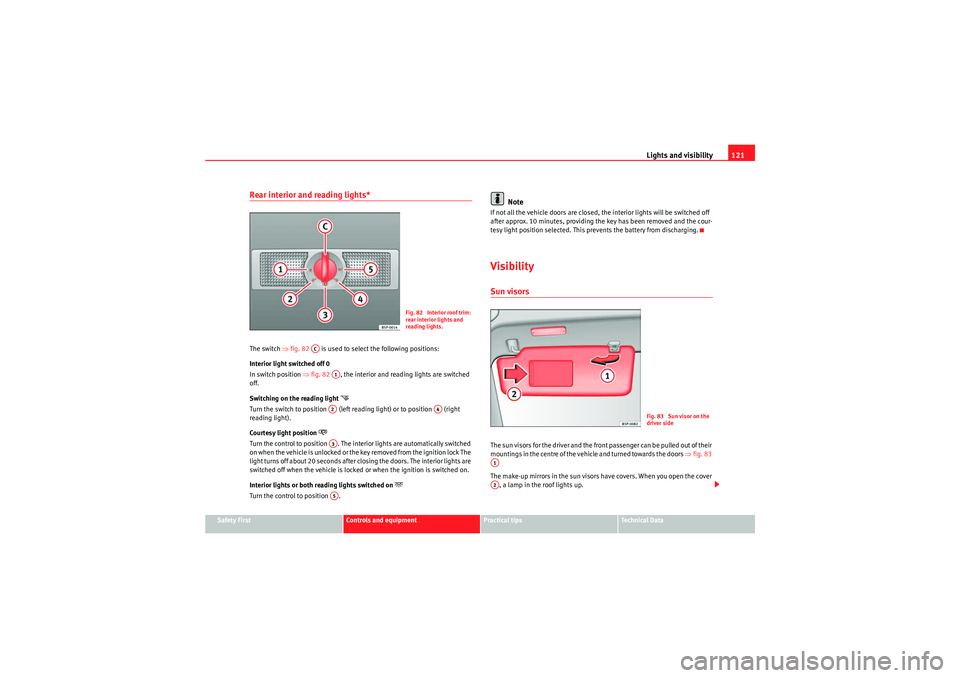
Lights and visibility121
Safety First
Controls and equipment
Practical tips
Technical Data
Rear interior and reading lights* The switch ⇒fig. 82 is used to select the following positions:
Interior light switched off 0
In switch position ⇒ fig. 82 , the interior and reading lights are switched
off.
Switching on the reading light
Turn the switch to position (left reading light) or to position (right
reading light).
Courtesy light position
Turn the control to position . The interior lights are automatically switched
on when the vehicle is unlocked or the key removed from the ignition lock The
light turns off about 20 seconds after closing the doors. The interior lights are
switched off when the vehicle is locked or when the ignition is switched on.
Interior lights or both reading lights switched on
Turn the control to position .
Note
If not all the vehicle doors are closed, the interior lights will be switched off
after approx. 10 minutes, providing the key has been removed and the cour-
tesy light position selected. This prevents the battery from discharging.VisibilitySun visorsThe sun visors for the driver and the front passenger can be pulled out of their
mountings in the centre of the vehicle and turned towards the doors ⇒fig. 83
The make-up mirrors in the sun visors have covers. When you open the cover , a lamp in the roof lights up.
Fig. 82 Interior roof trim:
rear interior lights and
reading lights.
AC
A1A2
A4
A3A5
Fig. 83 Sun visor on the
driver side
A1A2
Freetrack_EN.book Seite 121 Donnerstag, 10. September 2009 10:33 10
Page 124 of 294
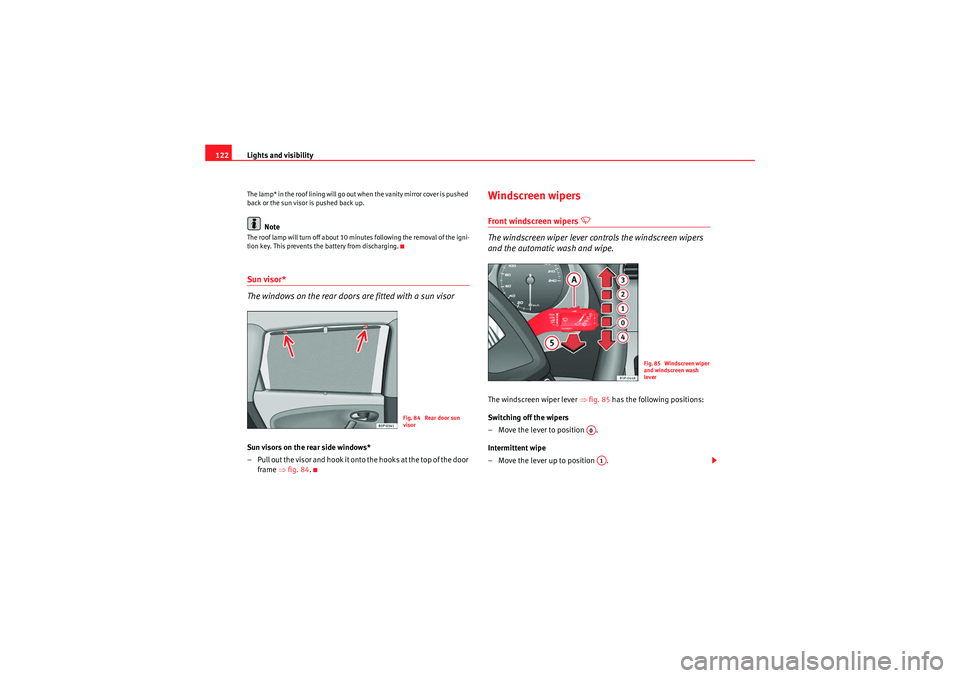
Lights and visibility
122The lamp* in the roof lining will go out when the vanity mirror cover is pushed
back or the sun visor is pushed back up.
Note
The roof lamp will turn off about 10 mi nutes following the removal of the igni-
tion key. This prevents the battery from discharging.Sun visor*
The windows on the rear doors are fitted with a sun visorSun visors on the rear side windows*
– Pull out the visor and hook it onto the hooks at the top of the door frame ⇒fig. 84 .
Windscreen wipersFront windscreen wipers
The windscreen wiper lever controls the windscreen wipers
and the automatic wash and wipe.
The windscreen wiper lever ⇒fig. 85 has the following positions:
Switching off the wipers
– Move the lever to position .
Intermittent wipe
– Move the lever up to position .
Fig. 84 Rear door sun
visor
Fig. 85 Windscreen wiper
and windscreen wash
lever
A0A1
Freetrack_EN.book Seite 122 Donnerstag, 10. September 2009 10:33 10
Page 125 of 294

Lights and visibility123
Safety First
Controls and equipment
Practical tips
Technical Data
– Move the control to the left or right to set the length of the
intervals. Control to the left: long intervals; control to the right:
short intervals. Four wiper interval stages can be set using switch .
Slow wipe
– Move the lever up to position .
Continuous wipe
– Move the lever up to position .
Brief wipe
– Move the lever down to position to give the windscreen a brief
wipe. The wiper will start to move faster if you keep the lever
pressed down for longer than 2 seconds.
Wash and wipe automatic system
– Pull the lever towards the steering wheel - Position . The wash function will start immediately and the wipers will start with a
slight delay. The wash and wipe r systems will function at the
same time at speeds of over 120 km/h.
– Release the lever. The wipers will keep running for approximately four seconds.Optional heated windscreen in the wiper blade* area (page
In some countries and with some versions, there is the possibility of heating
the windscreen in the area of the windscreen wiper blades in order to aid de-
icing in the zone. The function is switched on by pressing the rear heating
window key
.
WARNING
•Worn and dirty wiper blades obstruct visibility and reduce safety levels.•In cold conditions, you should not use the wash / wipe system unless
you have warmed the windscreen with the heating and ventilation system.
The washer fluid could otherwise freeze on the windscreen and obscure
your view of the road.•Always note the corresponding warnings on ⇒page 223, “Changing
windscreen wiper blades”.Caution
In icy conditions, always check that the wiper blades are not frozen to the
glass before using the wipers for the first time. If you switch on the wipers
when the wiper blades are frozen to the windscreen, you could damage both
the wiper blades and the wiper motor.
Note
•The windscreen wipers will only work when the ignition is switched on.•In certain versions of vehicles with alarms, the windscreen wiper will only
work when the ignition is on and the bonnet closed.•When in use, the wipers do not go as far as the rest position. When the
lever is moved to position 0, they are totally hidden.•T h e n e x t s p e e d d o w n w i ll a u t o m a t i ca ll y b e s e l e c t e d i f s p e e d ⇒page 122,
fig. 85 or is selected when the vehicle stops. The set speed will be
resumed when the vehicle starts again•The windscreen will be wiped again after approximately five seconds once
the “automatic wipe/wash system” has been operated, provided the vehicle
is in transit (drip function). If you activate the wipers less than three seconds
after the drip function, a new wash sequence will begin without the last wipe.
For the “drip” function to work again, you have to turn the ignition off and
then on again.
AA
AA
A2A3A4
A5
A2
A3
Freetrack_EN.book Seite 123 Donnerstag, 10. September 2009 10:33 10